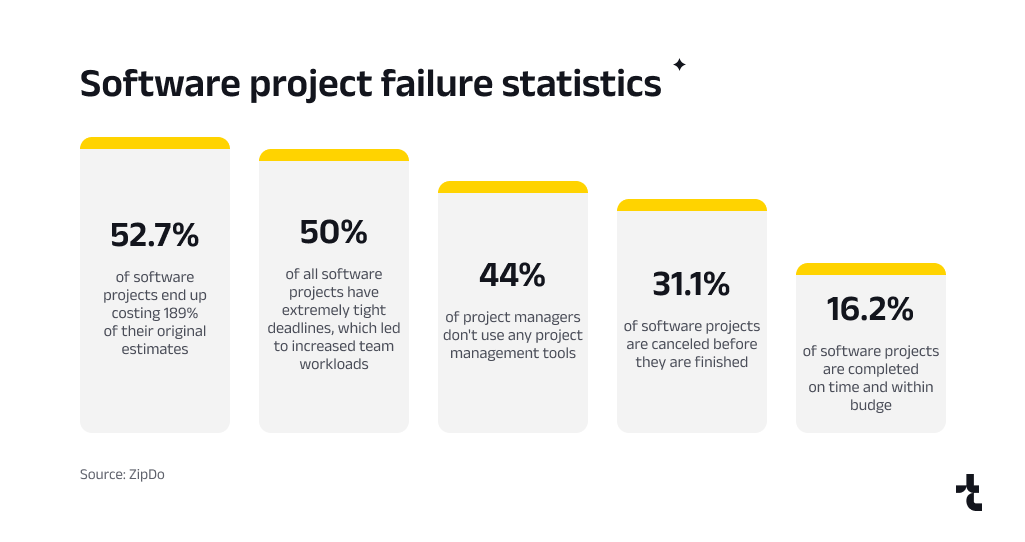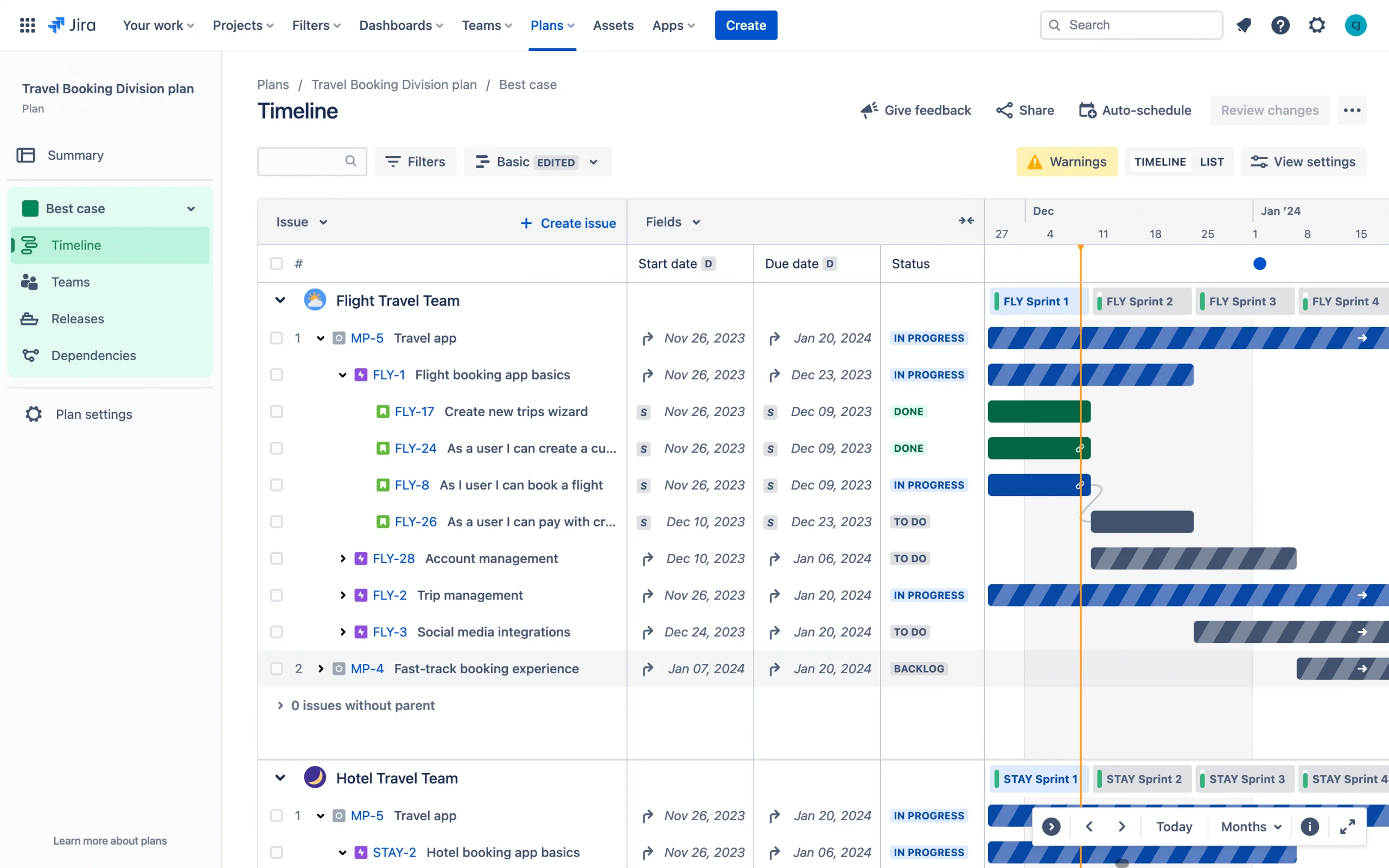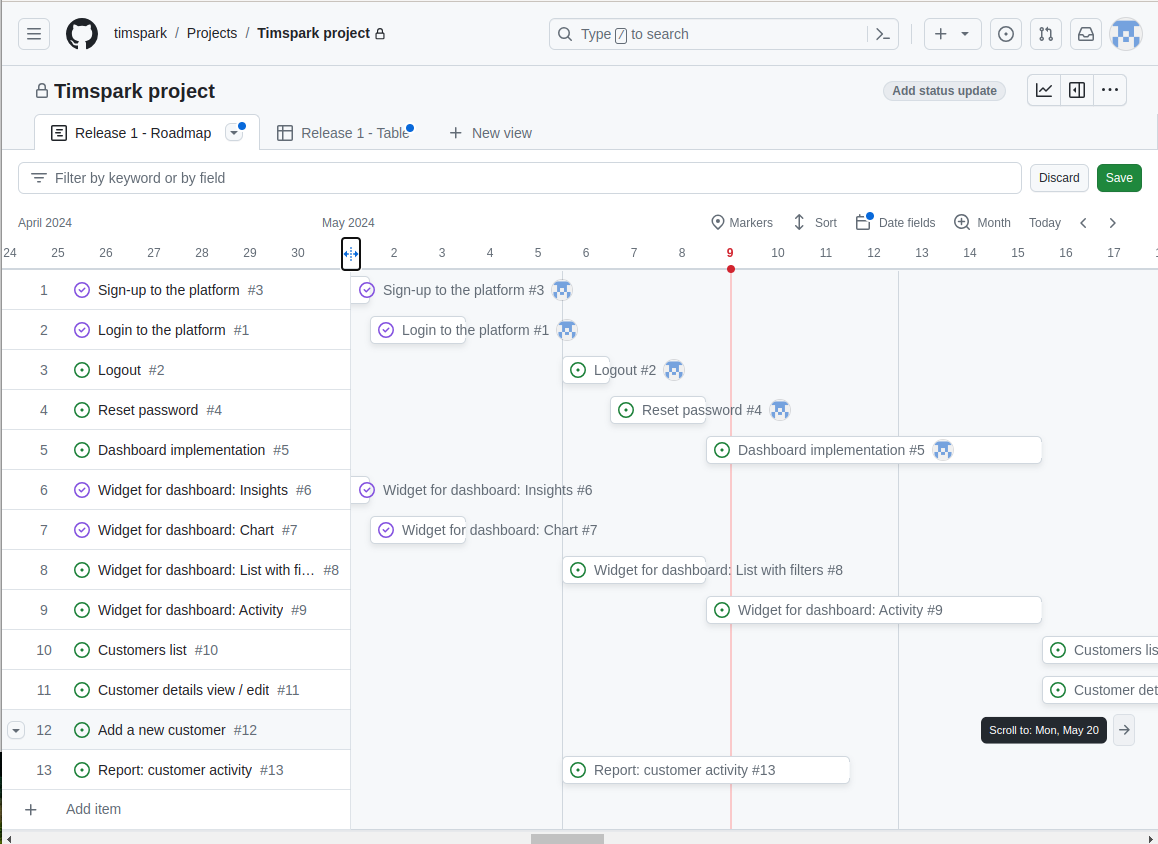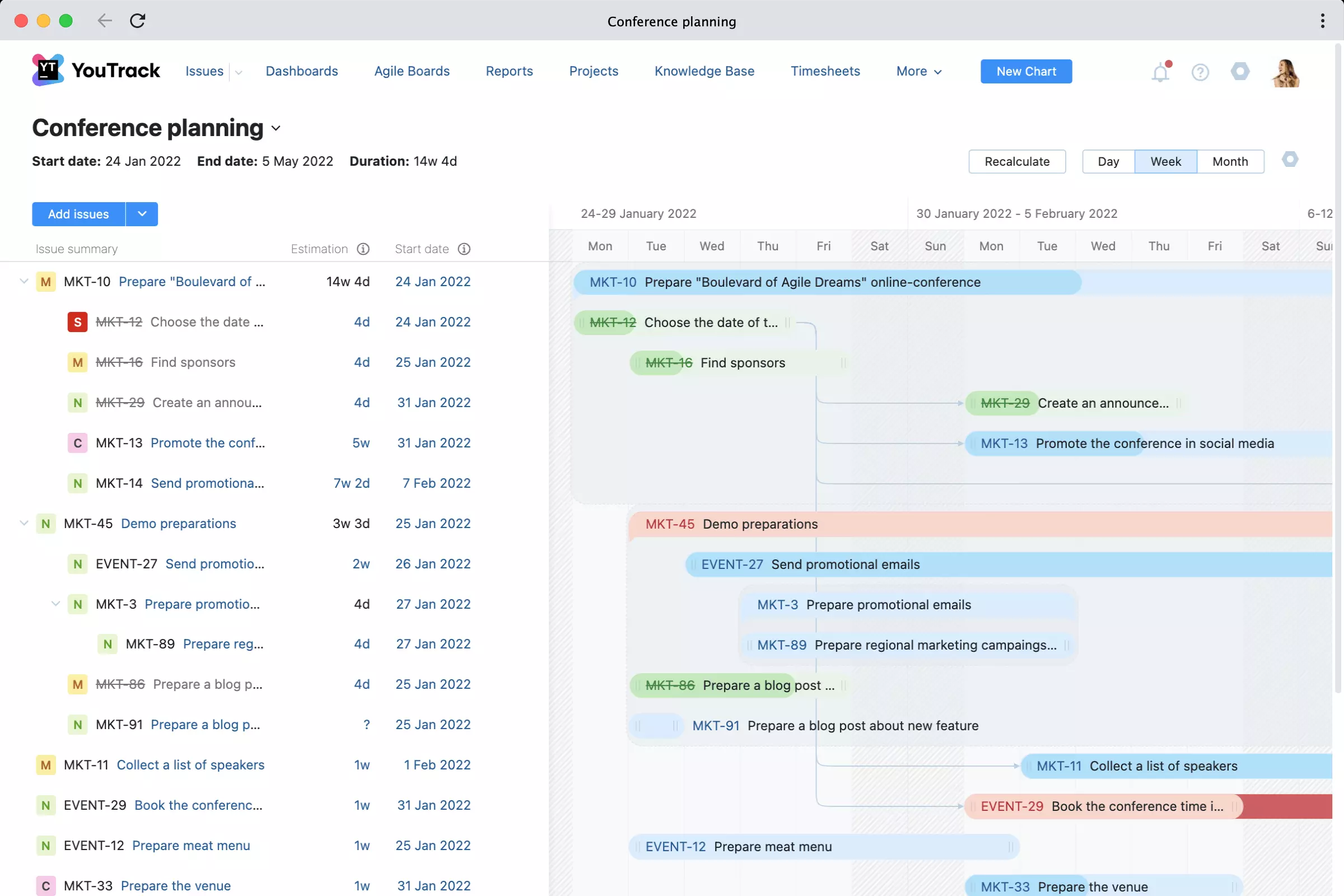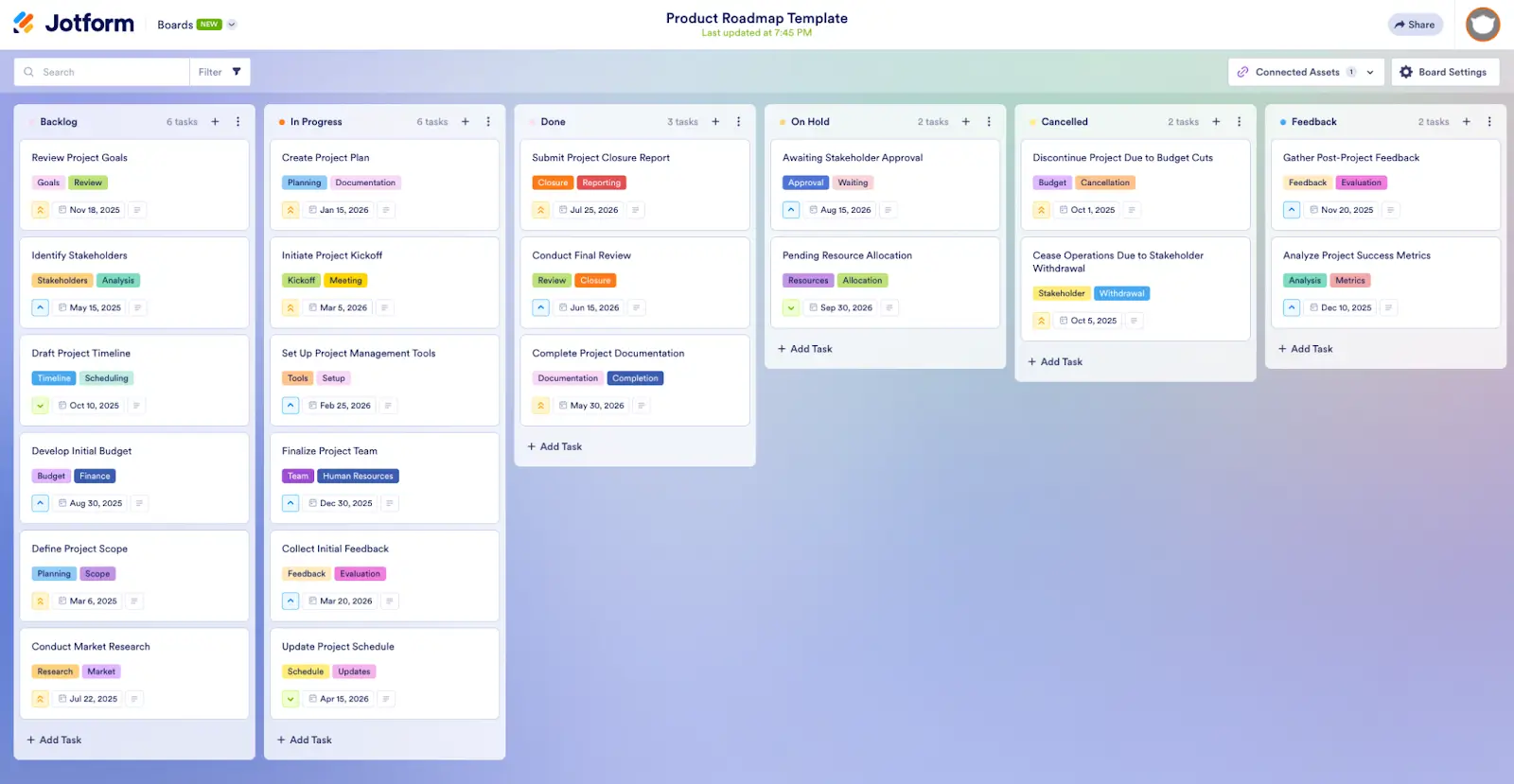Top 5 Tools for Workload Management and Other Project-Related Activities
Julia Teryokhina, Senior Presales Engineering Manager
February 24, 2025
In the dynamic world of software development, effective workload management software is the key to success, especially when it comes to managing team workload. It’s like orchestrating a symphony where every team member plays a crucial role. With the right workload management tools and techniques, tasks flow seamlessly, deadlines are met, and creativity thrives. No more asking, “Hey, has anyone seen the project plan?” only to find it being used as a coffee coaster. These tools to manage workload streamline communication, keep everyone on the same page, and ensure that every member’s workload is manageable. Ultimately, they empower teams to deliver top-notch software, on time and within budget—and with far fewer emergency pizza orders to keep everyone working late into the night.
ZipDo reports the following statistics:
Key aspects of project success with workload management
Before we start reviewing planning tools that can lead a project to success, let’s define what makes a project successful. Traditionally, a successful project is one that is completed within the agreed timeline, budget, and scope. However, many managers add a crucial fourth criterion: ensuring all team members go home on time without overtime. Tools like workload tracking software, collaboration platforms, and team workload tracker solutions can help keep projects on schedule while respecting work-life balance, creating the conditions for a truly successful outcome.
Here are the key areas in a project that require careful attention:
Project planning and tracking: the role of workload planning tools
This involves setting the timeline, milestones, deliverables, and team allocation (who is needed, when, and how many). Additionally, any activities that could impact deadlines, like setting up an Apple TestFlight account for mobile app testing, should be accounted for. Once the project begins, continuous tracking and recalibrating of the plan is crucial, especially if requirements or priorities change. Using a workload dashboard can help visualize real-time progress and make data-driven decisions.
Requirements management: ensuring consistency with workload management systems
Clear and consistent management of project requirements ensures that the final deliverables meet stakeholder expectations. This involves gathering, documenting, and maintaining requirements throughout the project lifecycle. It is particularly important to maintain consistency and coherence during the change management process as the project progresses.
Scope management: using workload management tools to stay on track
This process defines the work to be completed within a given timeline, preventing scope creep and keeping the project within agreed-upon boundaries. It involves setting clear objectives for each sprint and identifying key deliverables. Cross-links between planned tasks and their corresponding requirements are crucial, ensuring focus and alignment with project goals. By tracking and adjusting the scope for each sprint, teams can manage expectations and deliver results on time.
Team workload management: tools to manage workload and prevent burnouts
Effective workload monitoring is crucial to prevent burnout and ensure successful project execution, especially for remote development teams. A workload management system is essential for understanding each team member’s strengths, weaknesses, and current capacity. To accurately estimate workload, teams can use a tracker to establish initial task estimates, track remaining work for each task, and maintain a regular work log where team members record their work hours. Such software helps identify who is overloaded or underloaded, allowing for the redistribution of tasks and a balanced workload.
Quality management: automating workload tracking with workload management tools
This area is about ensuring project deliverables meet the expected standards and requirements. In addition to software functionality and usability, it covers code quality and technical debt management. Tools like SonarQube and GitHub CodeQL automate code quality checks within the CI/CD pipeline, identifying issues such as code smells and vulnerabilities. To monitor quality in real time and address problems quickly, project managers should choose team workload management tools with dashboards and comprehensive reporting features.
Delivery management: streamlining delivery with workload software
This involves organizing the final handover of the project, ensuring it is delivered to the client or other stakeholders on time and in line with expectations. The delivery package should include release notes describing new features, bug fixes, and other changes, a Quality Assurance (QA) report that presents test case execution results, and a report with key performance indicators (KPIs), such as schedule compliance, estimate accuracy, and budget variance. A key part of effective delivery management is using the right workload software to reduce manual effort when creating release notes and other deliverables. For workflow automation beyond development (e.g., administrative tasks), tools like Zapier can help, though healthcare teams should opt for HIPAA-compliant solutions like Keragon.
Top 5 project planning and workload management tools: chosen based on our experience and research
Using tools that integrate seamlessly within your development environment is crucial to effectively managing projects and software development teams. This minimizes manual efforts and reduces the risk of errors that often arise when switching between different systems. A cohesive ecosystem ensures smooth data flow, streamlined communication, and a unified view of the project’s status for all team members, leading to more successful project outcomes.
Based on our extensive experience and thorough research, we’ve selected the top 5 tools that are best suited for managing software development projects. These tools have been evaluated for their effectiveness, user experience, and integration capabilities within various development environments.
Tool #1: Atlassian Stack
The Atlassian stack is renowned for its comprehensive project management solutions. The popular combination of Jira, Confluence, and Bitbucket caters to the diverse needs and requirements of most projects. A major advantage of this setup is its seamless integration, allowing smooth data transitions and transparent processes for the whole team. This makes it easier for project managers to oversee every step with minimal effort.
For those seeking an alternative to Jira, Trello looks like a viable option. With its simplistic board-and-card system, Trello provides an easy way to visualize work in progress. However, its functionality is comparatively limited compared to Jira, particularly in terms of advanced reporting, complex workflow automation, and detailed project tracking. This simplicity makes Trello suitable for smaller teams, but Jira is preferable for those in need of a more comprehensive project management tool.
From automating task assignments to orchestrating workflow transitions based on specific triggers, Jira allows you to automate entire processes within the platform. Additionally, integration with other services ensures seamless data flow. Jira automation capabilities make project management more effortless, reducing manual labor and the risk of errors, thereby allowing project managers to focus on higher-level strategy and decision-making.
Here is how the Atlassian stack can be applied to the key areas of project management:
- Project planning and tracking: Jira excels in detailed iteration planning, featuring sprint tracking boards and reports (such as sprint velocity and team velocity), and Jira Roadmaps to visualize overarching project timelines. With Advanced Roadmaps, you can create comprehensive project plans that enable simultaneous management of multiple teams. However, it lacks features for automatic task rescheduling and resource leveling, which makes the process more manual and less automated. Trello, on the other hand, offers even fewer capabilities for planning and tracking project progress, but it works well for maintenance projects where you need to monitor open issues and prioritize their completion.
- Requirements management: Confluence serves as a robust solution for documentation tracking, including versioning and cross-references between wiki pages, ensuring requirements remain consistent and integrated.
- Scope management: Jira boards (SCRUM, Kanban, or custom configurations) and backlogs are effective for managing project and iteration scope. Trello, with its simplicity, is suitable for smaller projects, generally using the Kanban methodology.
- Team workload management: Jira provides features to compare the planned workload with the team capacity. This can be achieved through built-in tools, reports, and a wide range of community plugins.
- Quality management: Software quality control is a core aspect of Jira’s functionality. Integrating with code quality tools like SonarQube further enhances quality management by allowing for control of technical debt within the standard Jira workflow.
- Delivery management: Jira supports version and release management, including the automatic generation of release notes. Its close integration with Bitbucket or other CI/CD servers, like GitHub or GitLab, allows for automated delivery of packages throughout the entire pipeline.
Tool #2: GitHub Stack
GitHub is a great choice for remote software development teams, enabling code collaboration, issue tracking, and task management from anywhere.
Here’s how GitHub can be used to address key areas of project management:
- Project planning and tracking: GitHub Projects is ideal for Kanban-based iteration planning, offering customizable boards for task tracking. It provides tools like issues, milestones, and Gantt charts to organize and visualize project timelines. However, GitHub doesn’t support automatic task scheduling, resource leveling, or budget tracking.
- Requirements management: GitHub Wiki allows you to document requirements and maintain consistency across the project. However, its functionality is more basic compared to Confluence.
- Scope management: GitHub Issues allows you to create, assign, and track tasks, using labels to categorize items and milestones to mark project stages. However, GitHub is mainly Kanban-focused and lacks advanced Scrum features like sprint planning, burndown charts, and sprint retrospectives. For Scrum-specific functionality, consider third-party integrations like ZenHub.
- Team workload management: GitHub does not offer built-in features for work logs, task time estimates, remaining time tracking, or timesheet generation. You can use GitHub Projects and GitHub Insights as basic tools to manage workload by tracking task assignments and deadlines. To bridge the gaps in this functionality, one can apply to third-party integrations like ZenHub, WakaTime, or Clockify.
- Quality management: GitHub isn’t primarily designed for quality assurance (QA), but you can create a specific issue type called “Bug” to track open bugs in your software. Although GitHub doesn’t offer built-in QA reports, you can generate custom ones using third-party tools like Microsoft Power BI. Additionally, GitHub CodeQL can be used alongside SonarQube to enhance static analysis and improve security vulnerability detection.
- Delivery management: GitHub Actions can automate the delivery process, from building to deploying software. GitHub Releases lets you manage versions, create release notes, and distribute software to stakeholders, offering a complete solution for automated delivery and release management.
Tool #3: GitLab Stack
GitLab stands as another software development platform that fosters collaboration among remote engineers and cross-functional project teams. While being similar to GitHub, GitLab distinguishes itself through an array of built-in features, making it a more comprehensive tool for advanced project planning, scope management, team workload management, and quality management.
Here’s how GitLab covers each of the considered project management areas:
- Project planning and tracking: Like GitHub, GitLab focuses more on iteration planning than on comprehensive project planning and tracking. It also lacks resource leveling and automatic task scheduling. However, GitLab Issues offers robust tools for visualizing tasks and tracking project milestones, while the Roadmaps feature enables you to plan project timelines and track task dependencies.
- Requirements management: within GitLab lies a dedicated Requirements Management functionality, allowing users to create, track, and link requirements throughout the project lifecycle. Unlike GitHub Wiki, which provides basic documentation features, GitLab’s requirements management is structured and designed for detailed traceability. This feature enables you to establish relationships between requirements and issues, ensuring consistency and alignment across the project’s various stages.
- Scope management: GitLab Issues functions similarly to GitHub, but it includes Epics and Roadmaps, offering more extensive scope management for both projects and programs. With GitLab’s issue-tracking system and Agile boards (including Scrum and Kanban), you can define epics, stories, and tasks, set dependencies, and manage priorities. The Milestones feature allows you to set project phases and track progress toward key goals.
- Team workload management: GitLab provides team workload management tools, offering built-in reports, work-in-progress (WIP) tracking, and the ability to assign tasks to specific team members with set deadlines to manage capacity. Its Roadmaps and Epic features enable planning across multiple teams, while advanced analytics, burndown charts, and workload distribution reports ensure balanced workloads and help prevent overload.
- Quality management: GitLab’s Code Quality feature automatically scans code for issues, providing real-time feedback to developers. Additionally, GitLab supports integration with diverse code quality tools like SonarQube. GitLab presents an array of built-in QA reports showcasing detailed results from automated tests, code coverage reports to track the percentage of code covered by tests, security reports, and performance testing capabilities.
Delivery management: With GitLab’s CI/CD, you can set up automated pipelines to build, test, and deploy software. GitLab empowers users to define environments for different stages of deployment, such as staging and production, and configure rollbacks and automated deployment rules. GitLab’s Release feature supports version management and the generation of release notes, enabling seamless delivery and deployment processes.
Tool #4: YouTrack
YouTrack is a JetBrains tool that offers a variety of features to help manage software development teams and projects. Here’s how YouTrack can cover specific project needs:
- Project planning and tracking: By harnessing YouTrack’s capabilities, you can create multiple sprints, each with customizable start and end dates, allowing you to plan ahead and structure your project timeline. You can set deadlines, prioritize issues, and track project progress with various built-in reports and analytics. The platform offers burndown charts to monitor sprint progress and Gantt charts for visualizing project timelines and dependencies. Like the tools mentioned above, YouTrack doesn’t support automatic task scheduling or resource leveling.
- Requirements management: YouTrack’s Knowledge Base fosters users to create wiki-style articles to document project requirements, providing a platform for creating, organizing, and sharing project-related content. With features like issue linking, collaborative editing, and version control, you can link requirements to tasks, collect stakeholder feedback, and maintain a comprehensive record of requirement changes throughout the project lifecycle.
- Scope management: YouTrack provides flexibility through its Agile boards, supporting both Kanban and Scrum, with customizable workflows to manage tasks, user stories, sprints, and more. The Backlog feature allows you to prioritize issues and organize work for efficient planning and execution.
- Team workload management: YouTrack helps review team capacity with features like task tracking, work-in-progress (WIP) limits, and various visualizations. The built-in timesheet feature assists team members in logging work hours, providing insights into task time allocation. You can also create custom workflows to automate task assignments for even work distribution.
- Quality management: YouTrack facilitates quality management through customizable issue tracking, integration with code analysis tools like SonarQube, and a variety of QA reports, including the Matrix report. The Matrix report provides a visual representation of the relationship between different issues, such as issue criticality by epic, allowing you to analyze trends, assess risks, and prioritize tasks. This feature offers a tabular view for comparing metrics and gaining deeper insights into project dynamics.
- Delivery management: YouTrack can integrate with CI/CD tools like JetBrains’ TeamCity, GitHub, or GitLab, enabling automated delivery processes by connecting with CI/CD pipelines to streamline builds and deployments. While it doesn’t offer a built-in release note report or a dedicated release management feature, YouTrack allows you to automate tasks with custom workflows, and its customizable reports provide insights into delivery timelines and key milestones.
Tool #5: Microsoft Project
All the tools mentioned earlier lack the capacity to track an entire project plan, manage budgets, and calculate the required number of resources for each project stage. This is where Microsoft Project comes in. It’s a robust solution for detailed project planning, resource management, and scheduling. Supporting Gantt charts, critical path analysis, and automatic task scheduling, Microsoft Project is perfect for planning and tracking project releases. Its standout feature is resource leveling, automatically balancing workloads to prevent overallocation. It’s also excellent for detailed budget planning, setting milestones, and managing team capacity throughout various project stages. However, it might not be the best option for granular planning of smaller iterations. It offers fewer collaboration features than Atlassian and GitLab, despite integrating with other Microsoft tools like Teams and SharePoint. Thus, Microsoft Project can most effectively be used alongside other project management platforms as a complementary tool.
Tool #6: Jotform Boards
Jotform Boards is a simple, visual task management tool designed to help teams stay organized and easily track progress. Its main advantage for software development teams is the seamless integration with Jotform’s suite of products, which allows data from form submissions, approvals, AI agents and workflows to populate task boards automatically. This means no manual data entry is needed—tasks are created and tracked as soon as information is submitted.
Jotform Boards shines in its flexibility and ease of use. You can quickly set up custom boards that fit your team’s workflow, choosing from columns, task fields, and flows that best suit your project. It’s a great tool for managing tasks and processes that come directly from forms, like service requests or client feedback. However, it’s not designed for extremely complex project planning or detailed development cycles.
Here’s how software development teams can use Jotform Boards for various project management needs:
- Project planning and tracking: Jotform Boards is ideal for light task tracking rather than in-depth project planning. With its Kanban-style layout, teams can easily move tasks through different columns (e.g., “To Do,” “In Progress,” “Completed”). Tasks can be manually or automatically triggered from form submissions, which is especially useful for smaller teams or projects with less complexity. It’s best for teams focusing on straightforward task management.
- Requirements management: Jotform Boards doesn’t have a dedicated space for managing project requirements like tools such as Confluence or GitHub Wiki, but it allows teams to store documents, checklists, and data directly tied to tasks. You can attach requirements or supporting data to specific tasks, but it doesn’t have features like version control or cross-referencing, which are common in more robust documentation systems.
- Scope management: Customizable boards in Jotform Boards let teams define and track workflows, but they don’t provide native tools for handling complex scope management like epics. Teams can create custom fields to track progress, categorize work, or label different task types (e.g., “Bug Fix” or “Feature Development”). Still, for larger projects with multiple dependencies, you may need to rely on external tools to manage scope more comprehensively.
- Team workload management: Jotform Boards allows task assignments, priority setting, deadlines, and task comments to help software teams stay on top of who is doing what. With search and filter options, tracking progress and spotting overdue tasks is easy.
- Quality management: While Jotform Boards is not built specifically for software quality management (QA), it can help track issues like bugs or customer feedback through form submissions. For example, you could set up an automated task creation system that routes bug reports or support tickets into the appropriate task board. However, it lacks advanced QA features like code quality metrics that you’d find in developer-specific tools.
- Delivery management: Jotform Boards can help software teams manage delivery by using task statuses and due dates to track progress towards project milestones. Integrations with other Jotform products, such as email notifications or approval workflows, help coordinate everything.
So, which tools ensure project success?
With so many tools available, choosing the right one for your project can be challenging. The best choice often depends on your project’s specific needs. The technology stack or target deployment platform can significantly impact which project management tools are most suitable.
The need to fix the budget, stick to tight deadlines, or maintain flexibility through agile methodologies are all crucial factors to consider when choosing the right tools. Monitoring team workload is also essential, as this is critical to project success. Since business leaders often juggle multiple responsibilities, they usually have little time to manage the complexities of software development. That’s where our expert team comes in. With our support, you can focus on what truly matters: growing your business.
Want to launch a software development project?
References
1. Essential Software Project Failure Statistics In 2024. ZipDo, 2024.
2. Advanced planning guide in Jira. Atlassian, 2024.
3. GitHub Docs: Customizing the roadmap layout. GitHub, 2024.
4. GitLab Docs: Plan and track work. GitLab, 2024.
5. You plan your way with YouTrack. JetBrains, 2024.
6. Microsoft Project Online Feature Details. Microsoft, 2024.


